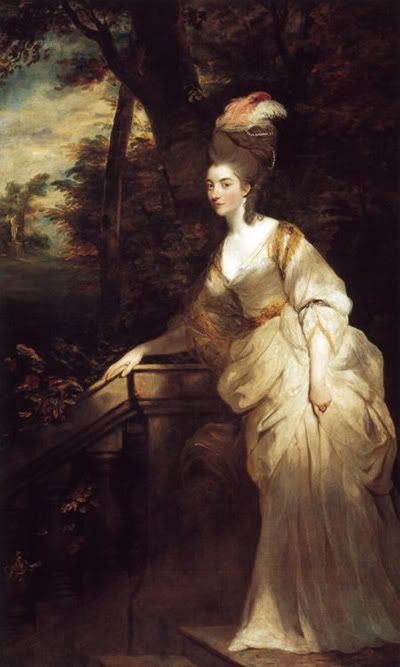Fashion in Reynolds and Gainsborough: Part 1
9:02 PMOK, I'm cheating a little here. This is a paper I wrote for my 18th Century Art class. But I got a 100 on it so hopefully you will like it as much as my professor did! It's about 13 pages long, so I will be posting it in parts throughout the next few weeks.
Sir Joshua Reynolds wrote several discourses on painting, many of which addressed his views on how the sitter should be dressed. In his Seventh Discourse (1776), he supported his views that sitters should be dressed in classical drapery which evokes ancient Greece and Rome, describing these civilizations as “the fountains from whence have flowed all kinds of excellence… we voluntarily add our approbation of every ornament that belonged to them, even to the fashion of their dress.” He felt that contemporary dress was undignified, and while the clothing of his sitters often retained the general shapes and lines of contemporary dress, overall it has an “air of the antique”, as Reynolds called it.

His portrait Gerogiana Cavendish, Duchess of Devonshire from c. 1775-6 shows the idea of a modern silhouette crossed with antique drapery. Although the dominant style of this time was still the robe a la francaise, the Duchess’s draped outfit carries a similar silhouette to the robe a la polonaise. The defining feature of the polonaise is the shape of the skirt, which is draped into three swags in the back, allowing the petticoat to be seen underneath. In Reynolds’ painting, the Duchess wears a gown with a fitted bodice, and an overskirt draped in swags, calling to mind the drapery of the polonaise. As the polonaise was still relatively new to the fashion scene, evoking this style allowed the Duchess to assert herself as the top fashionista, an idea heightened by her highly fashionable tall hairstyle. Additionally, Reynolds highlighted those features such as the neck and breasts that were considered the most beautiful and feminine in the period, giving promotion not only to the Duchess’s sense of style but to her personal beauty.
Despite all the elements of high fashion in his portrait, more prominent is the classicized view favored by Reynolds. The fabric of the Duchess’s draped gown has no luster, suggesting that it is not made of the highly fashionable silk taffeta or satin of the period, but a more simple material favored by the ancients. This aligns with Reynolds’ theory of fabric in historic painting, addressed in his Fifth Discourse (1772), where he writes “if the draperies were like cloth or silk of our manufacture, if the landskip had the appearance of a modern view, how ridiculous would Apollo appear instead of the sun, or an old Man with an Urn to represent a river or a lake.” The Duchess does not convey her wealth through the luxurious materials of her clothing, and instead reaches for the higher ideal of conveying a sense of timelessness. Her classicized dress and marble pale skin call to mind ancient statues of beautiful nymphs and goddesses, allowing the Duchess to take a rank amongst the great beauties that will never go out of style. The vague pastoral setting heightens this idea. By removing any references to modern architecture or other structures that would date the painting, the Duchess could be posing in any time and any place.



2 comments